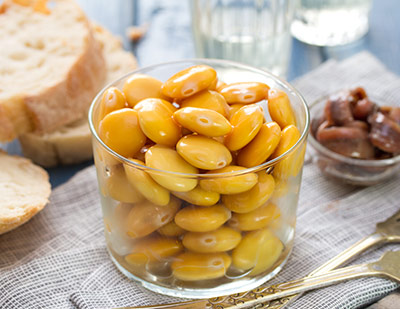Taste the world in your kitchen
The Difficult Bean: How to Prepare Lupins

In this world filled with convenience, we often forget to stop and smell the roses… or, in the world of food, we sometimes don’t take the time to try different things or go the extra mile to make a new dish.
Of course, for those whose passion lives in the kitchen, this may not be the case, but answer this question: how much time would you devote to a bean?
If you’re from a Mediterranean nation such as Italy, Lebanon, Spain or Portugal, you may be familiar with the lupini bean or lupin, otherwise known as the snack tremocos, but in the western world, lupins are relatively unknown, which means learning how to prepare them can be a difficult task.
Lupins are a very unique bean with an incredible number of nutritional advantages: they’re one of the best sources of plant proteins available, one of the highest sources of dietary fibre, are cholesterol-free, are a high source of essential amino acids, contain no starch, are probiotic and 100% gluten-free—not to mention delicious. Wow! Lupins are like a dietary supplement that’s delicious and enjoyable to eat. Why doesn’t everybody eat lupins every day? Well, lupins come with a catch: in order to unlock these fantastic qualities, the mighty lupin requires a little more preparation than its relatives in the bean family. How much more preparation? About a week. Hold on, come back, we’ll explain!
The reason lupins take this much time to prepare is twofold: texture and taste. When you open a package of lupins, you’ll see that the beans are very firm and dry, and if you pop one in your mouth you’ll notice a bitter taste. (Don’t bite down, you’ll chip a tooth! We mean it when we say these beans are firm before you cook them.) We can fix both of these issues by soaking the lupins for an extended period of time, which will soften the beans and remove that bitter taste. Patience is key with lupins—we want our beans to be tender and sweet, not hard and bitter.
Start by rinsing the beans with clean water to remove any dust or particles on the beans, then cover the beans with unsalted water in a large pot and soak them overnight. Drain, cover beans with water again and boil on high heat for about 10-15 minutes, then simmer until they start taking on a yellowish hue (up to 2 hours). Let the water cool with the beans still submerged, then drain and rinse the beans and refill the pot with cool, clean water. Place the pot in the fridge overnight, then drain it and refill it again. Rinse and repeat! You’ll need to drain the pot and refill it with water twice a day for approximately a week, give or take a day or two, or until the water no longer tastes bitter when tested. You can start tasting the beans after about three days to check if they’re still bitter or not. The beans should start to take on a sweet flavour as time progresses. On the last day, salt your beans by adding about three tablespoons of salt to the pot to create brine. This will help the flavour penetrate through the husk of the bean.
Once your beans are soft and sweet, they’re ready to eat! Eating lupins is a very satisfying process, similar to eating sunflower seeds or edamame. Break the bean’s husk with your teeth or fingernail and then simply squeeze one end to launch that little legume into your mouth. Mmmmm. Enjoy!
Lupins can be eaten in many ways, just like any other bean: mixed into salads, casseroles and stews or just eaten on their own with a little salt. It’s an Italian Christmas tradition to eat them with olives as finger food, but regardless of the season, they always make a great, healthy snack. Lupins will store in the fridge for about two weeks, a little longer if they’re stored in brine. Of course, if you don’t want to spend a week just to prepare a single batch of lupins, you can preserve your beans the same way you prepare pickles, olives or any other pickled product. Pickled lupins are always a welcome treat year-round.
If you’d like to try lupins for the first—or four hundredth—time, find your nearest CLIC retailer and pick some up! CLIC offers lupins in both dry pack and canned form in various sizes. If you’re in a rush and want to just jump in and chow down, canned lupins are ready to eat without any soaking or preparation required. Enjoy!
Do you prepare lupins differently? Do you have a recipe that you want to share? Send us a note and let us know how you like your lupin!
Note: please be advised that lupins may trigger allergic reactions in some peanut allergy sufferers. If you suffer from peanut allergies, consult a physician before coming into contact with lupins.

